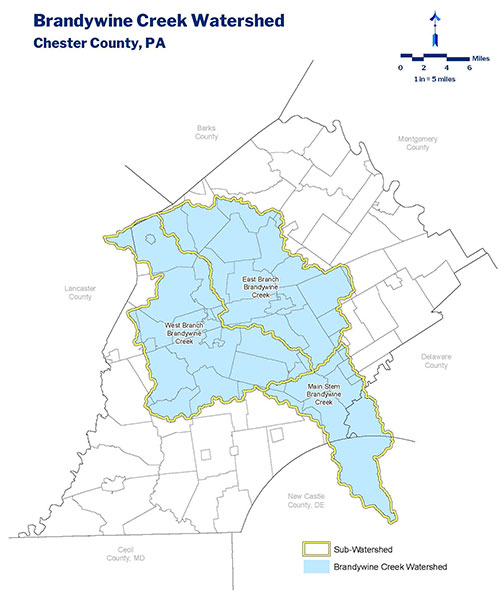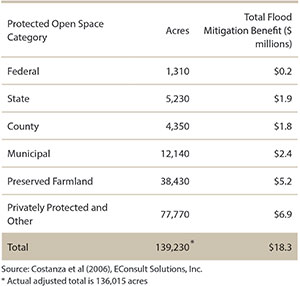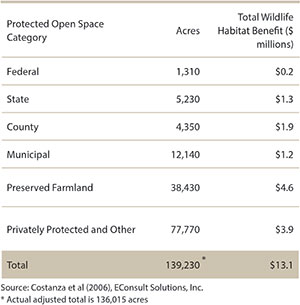Environmental Benefits
Protected open space provides value through naturally occurring environmental processes. If these lands were developed, Chester County would be forced to replicate vital services such as flood control and air and water pollution mitigation through costly alternative methods. In relying on the natural features on protected open spaces to provide these valuable services, Chester County and its communities avoid significant expenses. Return on Environment estimates the value and avoided costs associated with the following ecosystem services:
- Water supply replenishment
- Water quality protection and improvement
- Flood mitigation
- Wildlife habitat
- Air pollution removal
- Carbon sequestration and carbon storage
Additionally, the landscapes of protected open space naturally manage stormwater runoff. Return on Environment estimates the economic benefits associated with protected open space in the Brandywine Creek watershed in terms of its ability to reduce surface runoff volumes and filter pollutants and sediment from stormwater.
Water Supply
The soil of undeveloped land absorbs water, replenishing streams, reservoirs, and aquifers. This natural system provides for the continuous recharge of Chester County's groundwater and streams. Were this ecosystem service to fail, water would have to be imported from elsewhere, or local water would have to be more extensively treated, both of which are costly endeavors. Chester County realizes nearly $40 million in annual cost savings from natural water supply services on protected open space.

Water Quality
Natural landscapes, forests, and wetlands in particular, provide a natural protective buffer between human activities and water supplies like rivers, lakes, and the streams that feed them. This buffer prevents several types of contaminants, including pathogens, excess nutrients, metals, and sediments, from entering the water supply. Annually, Chester County receives $8.2 million in economic benefit from the ability of protected open space to naturally enhance water quality. Without protected open space, residents, businesses, and industry would be forced to pay for alternative groundwater filtration or water treatment methods.
Annual Water Quality Benefit by Category
of Protected Open Space
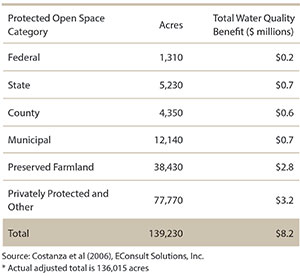
Flood Mitigation
Many natural landscapes serve as a buffer protecting people and properties from destructive natural events such as flooding. Protected open space helps to mitigate the risk of flood during storm events by slowing, trapping, and absorbing floodwaters. Protection of floodplains and riparian corridors in open space provides room for flood waters to be conveyed safely, slowed and stored by natural systems. Were the county to be not provided with these natural services, residents, industry, businesses, and local governments would be forced to pay an estimated $18.3 million per year to undertake costly measures to protect or recover their built environment from further damage as a result of flooding, such as constructing dams and levees, and relocating homes and businesses.

Wildlife Habitat
Chester County's protected open spaces harbor species that people value for both aesthetic and functional purposes. Values in this section estimate the amount of money that people would be willing to pay to preserve wildlife on protected open space in Chester County. An analysis using these values reveals that wildlife habitat on protected open space in Chester County has an estimated annual value of nearly $13.1 million.
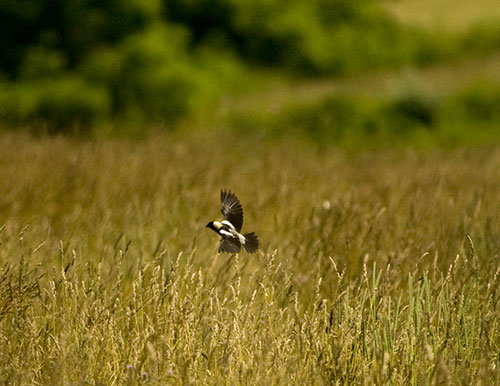
Photo credit: Carlos Alejandro
Air Pollution Removal
Poor air quality is common in many urban and suburban areas and can lead to a variety of human health problems, including asthma and other respiratory ailments. The pollutants that compromise air quality also can damage buildings and plants, cause smog, and disrupt the ecosystem. Trees mitigate significant amounts of air pollution through respiration processes that remove pollutants from the air. Using the total tree canopy acreage on protected open space and established estimates of the per-ton benefits of removing various airborne pollutants, it is estimated that trees on protected open space annually provide $13.5 million in air pollution removal services in Chester County that Chester County would otherwise have to pay to improve its air quality.
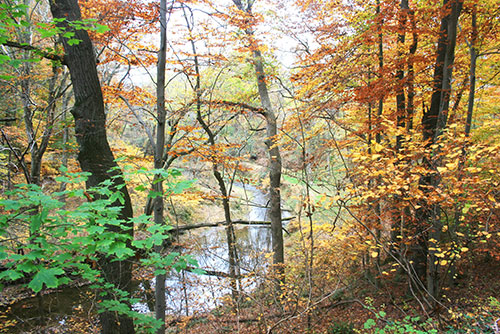
Carbon Sequestration and Storage
Trees mitigate the impacts of climate change by sequestering and storing atmospheric carbon from carbon dioxide. Carbon storage is an estimate of the total amount of carbon stored in the existing biomass of trees, both above and below ground. It is estimated that trees on Chester County's protected open space store 1,684,940 tons of carbon, equating to $120 million within their current biomass. This means if the carbon currently stored in trees on protected open space were released into the air, it would cause damages that would cost $120 million to mitigate. The storage of carbon in a tree represents a one-time benefit — the carbon is kept out of the atmosphere until the tree dies.
As a tree grows, it pulls carbon from the air through the process of photosynthesis. New growth on trees is responsible for carbon sequestration, which in contrast to the storage of carbon, is measured on an annual basis. Every year, new growth on the trees on protected open space in Chester County sequesters over 64,000 tons of carbon, which equates to an annual benefit of $4.6 million.
Estimated Amounts of Annual Carbon Sequestration
and Lifetime Carbon Storage and Associated Benefits
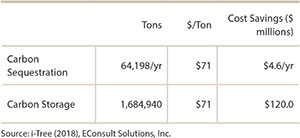
Stormwater Runoff and Pollution Mitigation
Protected open space generates much less stormwater runoff volume than unprotected developed lands and allows much less rainfall to reach streams as stormwater runoff, which helps to mitigate erosion, flooding, and water pollution.
A study of the Brandywine Creek watershed concluded that if all the county's protected open space within the watershed were developed at the same intensity as nearby unprotected (developed) lands, the annual volume of surface runoff would increase by nearly 2.1 billion gallons per year, or nearly 36,000 gallons per year for every acre of protected open space. This would be equivalent to 4.5 feet of water covering an area the size of the Borough of Downingtown (2.2 square miles).
The protected open space within the Brandywine Creek watershed avoids $263 million of capital construction costs for stormwater management systems, $27 million of annual operation and maintenance expenses for those systems, and $107 million of annual stormwater pollutant removal costs. These economic benefits apply to stormwater managed within only one of Chester County's watersheds, so the county-wide stormwater benefits provided by protected open space are significantly greater.
$263 million in avoided stormwater management capital costs
$27 million in avoided annual stormwater system maintenance
$107 million in annual stormwater pollutant removal costs
